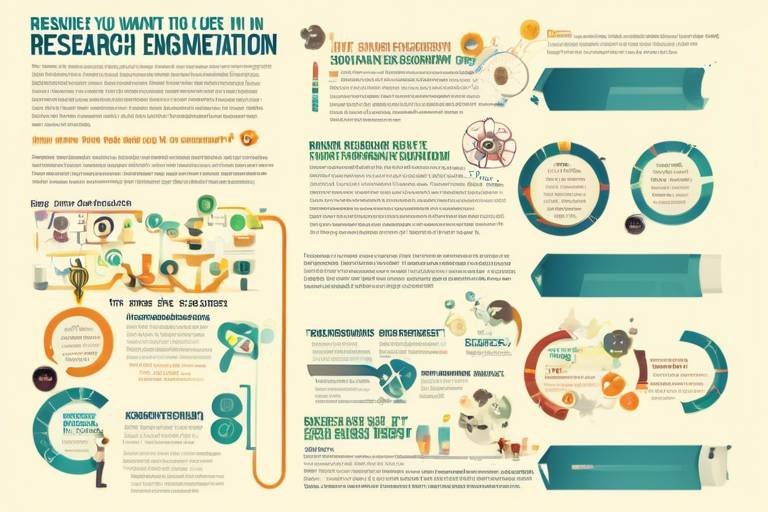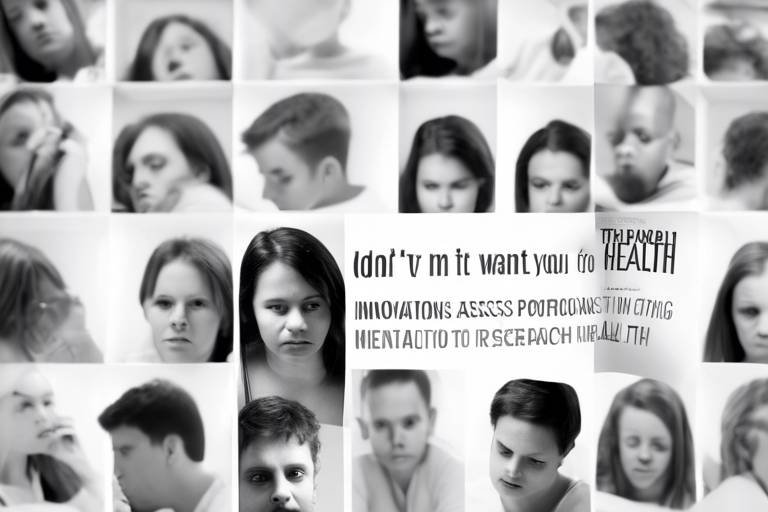How to Implement Agile Methodologies in Research Projects
In today’s fast-paced world, the need for adaptability and collaboration in research projects is more crucial than ever. Many research teams find themselves bogged down by traditional methodologies that often lead to inefficiencies and miscommunication. This is where Agile methodologies come into play. By integrating Agile principles into research projects, teams can enhance their flexibility, improve collaboration, and ultimately achieve their goals more efficiently.
So, how exactly can one implement Agile methodologies in research projects? It starts with understanding the core principles of Agile. Agile is not just a set of practices; it’s a mindset that encourages iterative progress, customer collaboration, and continuous improvement. Think of it as a way to navigate through the unpredictable waters of research, where conditions can change rapidly. By embracing Agile, research teams can respond to these changes with ease and keep their projects on track.
The first step in implementing Agile is to foster an environment that encourages collaboration. This means creating a culture where team members feel comfortable sharing ideas and feedback. In a research setting, this could involve regular brainstorming sessions or collaborative workshops. The more open the communication, the more innovative solutions can arise. Remember, research is often about exploring the unknown, and collaboration can lead to breakthroughs that might not happen in isolation.
Another key aspect of Agile is the use of iterative development. This approach allows teams to break their projects into smaller, manageable chunks, or iterations. Each iteration involves planning, executing, and reviewing the work done. This cycle not only helps in refining the research process but also allows for regular assessment of progress. It’s like taking small, calculated steps on a journey rather than trying to leap across a chasm. By focusing on smaller goals, teams can maintain momentum and adjust their strategies based on real-time feedback.
In addition to fostering collaboration and iterative development, Agile emphasizes the importance of stakeholder involvement. In research, stakeholders can include funding bodies, academic peers, or even the community impacted by the research. Regular feedback from these stakeholders can help ensure that the research remains aligned with its goals and addresses the needs of those it aims to serve. Agile methodologies facilitate this involvement by encouraging regular check-ins and updates, which can significantly enhance the relevance and impact of the research outcomes.
While implementing Agile methodologies can significantly improve research projects, it’s essential to recognize that challenges may arise. For instance, teams accustomed to traditional methods may resist change. Addressing this resistance requires patience and education. It’s crucial to communicate the benefits of Agile clearly and to involve team members in the transition process. By doing so, you can cultivate a culture that embraces change rather than shying away from it.
Moreover, maintaining focus on research objectives is vital. Agile’s inherent flexibility can sometimes lead to scope creep, where the project expands beyond its original goals. To combat this, it’s essential to keep the research objectives clear and ensure that all iterations align with these goals. Regularly revisiting the project’s objectives can help keep the team grounded and focused on delivering meaningful results.
- What are the core principles of Agile methodologies? Agile methodologies emphasize flexibility, customer collaboration, and continuous improvement.
- How can Agile enhance collaboration in research projects? Agile promotes teamwork and open communication, leading to innovative solutions and a more engaged research team.
- What is iterative development? Iterative development involves breaking down projects into smaller, manageable iterations for continuous refinement and assessment.
- How can I involve stakeholders in the Agile process? Regular check-ins and updates with stakeholders can ensure their feedback is integrated throughout the research process.
- What challenges might I face when implementing Agile? Resistance to change and scope creep are common challenges, but they can be addressed through clear communication and focus on objectives.

Understanding Agile Methodologies
Agile methodologies are not just a set of practices; they represent a fundamental shift in how teams approach projects. At its core, Agile is all about iterative progress and collaboration. Imagine trying to build a bridge. Instead of waiting until the entire structure is complete to see if it holds up, Agile encourages teams to build in small sections, testing and adjusting as they go. This approach allows for flexibility, enabling teams to respond to changes quickly and effectively.
One of the key principles of Agile methodologies is customer collaboration. In research projects, this means engaging with stakeholders throughout the process, not just at the beginning or end. By involving stakeholders at every stage, researchers can gather valuable insights and feedback that can shape the direction of the project. This constant interaction ensures that the research remains relevant and aligned with the needs of those it aims to serve.
Another fundamental aspect of Agile is the emphasis on continuous improvement. Agile teams regularly reflect on their processes and outcomes, identifying areas for enhancement. This could involve adopting new tools, refining communication methods, or adjusting workflows. The goal is to create a culture where learning and adaptation are integral to the research process.
To sum it up, the Agile methodology is built on several core principles that can significantly enhance research projects:
- Flexibility: Adapting to changes and new information.
- Collaboration: Engaging with stakeholders and team members throughout the project.
- Continuous Improvement: Regularly assessing and refining processes for better outcomes.
By embracing these principles, research teams can foster an environment that not only enhances productivity but also encourages innovation and creativity. In the fast-paced world of research, where new discoveries and technologies emerge daily, having the ability to pivot and adapt is invaluable. Agile methodologies equip teams with the tools they need to navigate the complexities of research effectively.

Benefits of Agile in Research
Implementing Agile methodologies in research projects is not just a trend; it’s a transformative approach that brings a multitude of benefits. One of the most significant advantages is the increased adaptability to change. In research, where variables can shift unexpectedly—be it due to new findings, budget constraints, or changing stakeholder needs—Agile allows teams to pivot quickly without losing momentum. This flexibility is akin to a skilled dancer who can change direction mid-performance, seamlessly adapting to the rhythm of the music.
Moreover, Agile enhances stakeholder engagement. In traditional research methods, stakeholders might feel disconnected from the process, only seeing results at the end. Agile flips this script by involving them throughout the research lifecycle. Regular feedback loops ensure that the project stays aligned with stakeholder expectations, leading to outcomes that are not only timely but also relevant. Imagine a chef inviting diners into the kitchen to taste and suggest adjustments to the dish before it’s served—this is the essence of Agile in research.
Another notable benefit is the faster delivery of results. Agile methodologies promote the idea of breaking down research into smaller, manageable iterations or sprints. This means that instead of waiting months or years for a final report, researchers can deliver preliminary findings much sooner. These early results can be invaluable, allowing for adjustments and refinements before the final project wraps up. It’s like building a house; instead of waiting for the entire structure to be completed, you can move into a livable space while the finishing touches are still being applied.
In addition to these advantages, Agile fosters a culture of continuous improvement. With regular retrospectives, teams can reflect on what’s working and what isn’t, making necessary adjustments to their processes. This iterative approach not only enhances the quality of the research but also boosts team morale as members see their contributions leading to tangible improvements. It’s like tuning a musical instrument; the more you refine it, the sweeter the sound becomes.
To summarize, the benefits of adopting Agile methodologies in research projects can be encapsulated as follows:
- Increased adaptability to changing circumstances.
- Enhanced stakeholder engagement through regular feedback.
- Faster delivery of results with iterative work cycles.
- Continuous improvement through reflection and adaptation.
In conclusion, integrating Agile into research not only streamlines processes but also leads to more impactful and relevant outcomes. The dynamic nature of research demands a flexible approach, and Agile provides the framework to meet these demands effectively.
Q: What is Agile methodology?
A: Agile methodology is a project management approach that emphasizes iterative progress, collaboration, and flexibility. It allows teams to adapt to changes quickly and deliver results incrementally.
Q: How can Agile improve research outcomes?
A: By promoting regular stakeholder engagement, faster delivery of results, and continuous improvement, Agile methodologies can lead to more relevant and impactful research findings.
Q: What challenges might we face when implementing Agile in research?
A: Common challenges include resistance to change from team members and the potential for scope creep due to Agile's flexibility. Addressing these issues proactively can facilitate a smoother transition.

Enhanced Collaboration
In the realm of research, collaboration is not just a buzzword; it's the lifeblood of innovation. Agile methodologies inherently promote teamwork and open communication among researchers, creating an environment where ideas can flourish. Imagine a bustling café where everyone is sharing thoughts over coffee; that's the kind of atmosphere Agile aims to cultivate in research teams. By breaking down silos and encouraging cross-functional collaboration, Agile helps researchers tap into diverse perspectives, leading to more innovative solutions and a heightened sense of engagement within the team.
One of the key elements of fostering this collaborative spirit is the establishment of a culture that values feedback and continuous improvement. When team members feel safe to express their ideas and concerns, it opens the door for creative problem-solving. For instance, regular brainstorming sessions can be held where everyone contributes their insights, akin to a potluck dinner where each dish adds flavor to the meal. This collaborative approach not only enhances the quality of the research but also strengthens team cohesion.
Moreover, Agile encourages the use of visual management tools such as Kanban boards and burndown charts. These tools serve as a visual representation of the project's progress, making it easier for everyone to see what needs to be done and who is responsible for each task. This transparency fosters accountability and ensures that no task falls through the cracks. Just like a well-orchestrated symphony, every team member knows their role, and together they create harmonious results.
To further illustrate the benefits of enhanced collaboration in Agile research projects, consider the following table that outlines key collaborative practices:
| Collaborative Practice | Description | Benefits |
|---|---|---|
| Daily Stand-ups | Short meetings to discuss progress and obstacles. | Increased accountability and alignment. |
| Retrospectives | Regular meetings to reflect on what worked and what didn't. | Continuous improvement and innovation. |
| Pair Programming | Two researchers work together on a single task. | Enhanced problem-solving and knowledge sharing. |
In conclusion, embracing Agile methodologies in research not only enhances collaboration but also creates a vibrant ecosystem where ideas can thrive. By prioritizing teamwork and open communication, research teams can navigate challenges more effectively, leading to groundbreaking discoveries and a more engaged workforce. So, are you ready to break down the walls and foster a culture of collaboration in your research projects?
Q: How does Agile enhance collaboration in research?
A: Agile enhances collaboration by promoting open communication, encouraging feedback, and utilizing visual management tools that keep everyone aligned and accountable.
Q: What are some common Agile practices that support collaboration?
A: Common Agile practices include daily stand-ups, retrospectives, and pair programming, all of which foster teamwork and innovation.
Q: Can Agile methodologies be applied to all types of research?
A: While Agile is particularly effective in dynamic and iterative research environments, its principles can be adapted to various types of research projects to improve collaboration and outcomes.

Daily Stand-ups
Daily stand-up meetings are a cornerstone of Agile methodologies, acting like a daily pit stop for research teams. Imagine a racing team that needs to refuel and check their strategy before hitting the track again—this is exactly what stand-ups provide. These brief, focused meetings, typically lasting no more than 15 minutes, allow team members to share updates, discuss challenges, and align their efforts towards common goals. The beauty of these gatherings lies in their simplicity and efficiency.
During a daily stand-up, each team member answers three critical questions: What did I accomplish yesterday?, What do I plan to accomplish today?, and What obstacles are blocking my progress? This format not only promotes accountability but also ensures that everyone is aware of each other's progress and challenges. By keeping the meeting short and to the point, teams can maintain their momentum and avoid the pitfalls of lengthy discussions that can derail productivity.
Moreover, daily stand-ups foster a culture of transparency and communication. When team members openly share their challenges, it encourages problem-solving and collaboration. For instance, if one researcher is facing a significant hurdle, others may offer insights or assistance, transforming potential roadblocks into opportunities for teamwork. This collaborative spirit is essential for innovation, as diverse perspectives often lead to unique solutions.
To maximize the effectiveness of daily stand-ups, consider the following best practices:
- Stick to a Schedule: Consistency is key. Holding stand-ups at the same time and place each day helps establish a routine.
- Encourage Participation: Ensure that everyone has a chance to speak. This not only keeps the team informed but also boosts engagement.
- Focus on Solutions: If problems arise, encourage team members to discuss potential solutions rather than dwelling on the issues.
In conclusion, daily stand-ups are more than just meetings; they are a vital practice that enhances team alignment, promotes accountability, and fosters a collaborative environment. By integrating this practice into your research projects, you can ensure that your team remains focused, engaged, and agile, ultimately leading to more successful outcomes.

Stakeholder Involvement
In the realm of research projects, is not just a nice-to-have; it's a crucial element that can make or break the success of your project. Imagine embarking on a road trip without a map or a destination in mind—chaotic, right? That’s what a research project feels like without the active participation of stakeholders. By actively involving stakeholders throughout the research process, you can ensure that their insights and needs are integrated into the project from the very beginning.
Agile methodologies excel in facilitating this involvement through regular feedback loops. These loops allow stakeholders to voice their opinions and provide input on various aspects of the project, ensuring that the research remains aligned with their expectations and goals. One of the most effective ways to achieve this is through iterative reviews, where stakeholders can assess progress and suggest changes at each stage of the project.
Furthermore, involving stakeholders can lead to a more engaged research team. When team members see that their work directly impacts the stakeholders, it fosters a sense of ownership and accountability. It’s like passing the baton in a relay race; everyone must be in sync to reach the finish line successfully. Here are a few strategies to enhance stakeholder involvement:
- Regular Check-ins: Schedule consistent meetings to update stakeholders on progress and gather their feedback.
- Surveys and Questionnaires: Use these tools to collect input from a larger group of stakeholders who may not be able to attend meetings.
- Workshops: Organize collaborative sessions where stakeholders can brainstorm and contribute ideas.
By implementing these strategies, the research team not only enriches the project with diverse perspectives but also cultivates a culture of collaboration and transparency. This dynamic environment encourages innovation and can lead to unexpected breakthroughs that might not have surfaced in a more traditional, isolated research setting. Remember, stakeholder involvement is not just about keeping them informed; it’s about making them an integral part of the journey. Their insights can lead to more relevant research outcomes and ensure that the final results resonate with the intended audience.
Q: How often should we involve stakeholders in the research process?
A: It's beneficial to involve stakeholders at every stage of the project, with regular check-ins and feedback sessions to ensure ongoing alignment.
Q: What if stakeholders have conflicting opinions?
A: Conflicting opinions can be addressed through open discussions, prioritizing the project's goals, and finding common ground that aligns with the research objectives.
Q: Can stakeholder involvement slow down the research process?
A: While it may seem that involving more people could slow things down, the benefits of gaining valuable insights and ensuring alignment often outweigh the potential delays.

Iterative Development in Research
When it comes to research projects, embracing an iterative development approach can be a game changer. Imagine you're on a road trip, but instead of a fixed destination, you have multiple exciting stops along the way. Each stop allows you to assess your progress, make necessary adjustments, and enjoy the journey. This is precisely how iterative development works in research—it breaks down the project into smaller, manageable segments, or iterations, which can be evaluated and refined continuously.
In practice, this means that researchers can focus on delivering a minimum viable product (MVP) at the end of each iteration. For instance, if you're working on a complex study involving data collection and analysis, you might start with a pilot phase where you test your methods on a smaller scale. This allows you to gather initial feedback and identify potential issues before scaling up. By doing so, you not only save time and resources but also enhance the overall quality of your research.
Moreover, the iterative approach fosters a culture of continuous improvement. Each cycle offers the opportunity to reflect on what worked well and what didn’t, leading to better decision-making in subsequent iterations. This can be particularly beneficial in research environments where unexpected challenges often arise—think of it as a safety net that allows you to pivot and adjust your strategies without derailing the entire project.
One of the key advantages of this method is its ability to facilitate collaboration among team members. As researchers work through each iteration, they can engage in regular discussions, share insights, and collectively brainstorm solutions to problems. This collaborative spirit not only enhances creativity but also ensures that everyone is on the same page, reducing the risk of miscommunication.
To illustrate this approach further, consider the following table, which outlines the typical phases of an iterative development cycle in research:
| Phase | Description | Outcome |
|---|---|---|
| Planning | Define objectives and scope for the iteration. | Clear goals and a roadmap for the iteration. |
| Execution | Conduct research activities based on the defined plan. | Initial data collection and analysis. |
| Review | Evaluate the results and gather feedback. | Insights for improvement and adjustments. |
| Refinement | Make necessary changes based on feedback. | A more robust plan for the next iteration. |
In summary, adopting an iterative development approach in research not only enhances efficiency but also promotes a culture of adaptability and collaboration. By breaking projects into smaller segments, researchers can respond to changes more effectively, ensuring that they remain aligned with their overall objectives while continuously improving their methods and outcomes.
- What is iterative development? Iterative development is a process that breaks down projects into smaller, manageable segments, allowing for continuous evaluation and improvement.
- How does iterative development benefit research? It enhances flexibility, encourages collaboration, and allows for timely adjustments based on feedback.
- Can iterative development be applied to all types of research? Yes, while it is particularly effective in complex projects, many research types can benefit from this approach.

Common Challenges in Agile Implementation
Implementing Agile methodologies in research projects can be a game-changer, but it’s not without its hurdles. One of the most significant challenges teams face is resistance to change. Many researchers are accustomed to traditional project management methods, which can create a comfort zone that’s hard to break. Think of it like trying to teach an old dog new tricks; it’s not impossible, but it requires patience and understanding. To overcome this resistance, it’s essential to foster a culture that embraces Agile principles. This can be achieved by providing training sessions, sharing success stories from other teams, and encouraging open discussions about the benefits of Agile.
Another common obstacle is maintaining focus on objectives. Agile’s inherent flexibility can sometimes lead teams down a rabbit hole of scope creep, where the project starts to drift away from its original goals. Imagine setting out on a road trip with a clear destination, but getting sidetracked by every interesting roadside attraction. While some detours can be fun and enlightening, they can also lead you far off course. To keep research objectives clear, teams should establish a well-defined project scope from the outset. Regular check-ins and reviews can help ensure that all iterations remain aligned with the overall goals.
Moreover, communication breakdowns can occur if team members are not on the same page. Agile thrives on collaboration and transparency, but if the communication channels are not well-established, misunderstandings can arise. For instance, if one team member is unaware of changes made in a previous iteration, it can lead to duplicated efforts or conflicting results. To mitigate this risk, implementing tools like shared dashboards or project management software can help keep everyone informed and engaged.
Lastly, time management can be a tricky aspect of Agile implementation. While Agile promotes iterative work cycles, some teams may struggle to balance the time spent on iterations with the overall project timeline. This can lead to a rushed final product or burnout among team members. It’s crucial to set realistic timelines and to allocate time for reflection and adjustments after each iteration. This not only helps in managing time effectively but also allows for continuous improvement in the research process.
- What is Agile methodology? Agile methodology is a project management approach that emphasizes iterative progress, collaboration, and flexibility, allowing teams to adapt to changes quickly.
- How can I overcome resistance to Agile? To overcome resistance, provide training, share success stories, and foster an open culture that encourages discussions about Agile benefits.
- What are the key benefits of Agile in research? Agile enhances adaptability, improves stakeholder engagement, and accelerates the delivery of results, making it a valuable approach for research projects.
- How can I maintain project focus in Agile? Establish a clear project scope and conduct regular check-ins to ensure that the team stays aligned with the overall research objectives.

Resistance to Change
Change is like a double-edged sword; it can either cut through the old ways and usher in new opportunities or create confusion and pushback from those who are set in their ways. In the context of implementing Agile methodologies in research projects, resistance to change is a common hurdle that many teams face. This resistance often stems from a deep-rooted comfort with traditional methods, where processes are linear and predictable. When faced with the dynamic and iterative nature of Agile, team members might feel uncertain or insecure about their roles, leading to reluctance in adopting new practices.
To tackle this resistance effectively, it's crucial to foster a culture that embraces change as a positive force rather than a threat. Here are some strategies that can help:
- Education and Training: Providing comprehensive training sessions about Agile principles can demystify the methodology. When team members understand the benefits and the 'why' behind Agile, they are more likely to embrace it.
- Involvement in the Process: Involve team members in the transition process. When they feel like they have a say in how Agile is implemented, they are more likely to support it.
- Showcase Quick Wins: Highlighting early successes from Agile practices can serve as powerful motivation. When team members see tangible results, their skepticism may begin to fade.
Additionally, leadership plays a vital role in overcoming resistance. Leaders must model Agile behaviors, demonstrating flexibility and openness to feedback. It’s important for them to communicate that mistakes are part of the learning process in Agile, encouraging a mindset that views failures as opportunities for growth.
Ultimately, addressing resistance to change is not just about implementing new practices; it’s about transforming the organizational culture. By fostering an environment that values collaboration, transparency, and continuous improvement, research teams can not only overcome resistance but also thrive in the Agile landscape. Remember, change doesn’t happen overnight, but with patience and persistence, the transition can lead to remarkable improvements in research outcomes.
- What is Agile methodology? Agile methodology is an iterative approach to project management and software development that emphasizes flexibility, collaboration, and customer feedback.
- Why is Agile beneficial for research projects? Agile enhances adaptability, improves stakeholder engagement, and accelerates the delivery of results, making it especially valuable in research environments.
- How can I overcome resistance to Agile in my team? Education, involvement in the process, and showcasing quick wins are effective strategies to help team members embrace Agile methodologies.

Maintaining Focus on Objectives
In the fast-paced world of Agile methodologies, it can be all too easy to lose sight of your original research objectives. The flexibility that Agile offers is undoubtedly one of its greatest strengths, allowing teams to pivot and adapt as new information emerges. However, this very flexibility can also lead to what is known as scope creep, where the project gradually expands beyond its initial goals. This is why maintaining a clear focus on objectives is crucial for ensuring that your research remains on track and delivers meaningful results.
To keep your team aligned with the project’s objectives, it’s essential to establish a clear vision from the outset. This vision should be documented and communicated effectively among all team members. By doing so, you create a shared understanding of what success looks like. Regularly revisiting this vision during your Agile sprints can help reinforce the team’s commitment to the objectives, ensuring that everyone is working towards the same end goal.
Another effective strategy for maintaining focus is to implement iteration reviews. At the end of each sprint, take the time to assess what was achieved against the original objectives. This not only provides an opportunity for reflection but also allows for necessary adjustments to be made for the upcoming iterations. During these reviews, consider asking questions such as:
- Did we meet our objectives for this sprint?
- What challenges did we face, and how can we address them moving forward?
- Are there any new insights that require us to adjust our objectives?
By fostering a culture of open communication and continuous improvement, you empower your team to voice concerns or suggest changes without fear of derailing the project. This collaborative approach ensures that everyone is not only aware of the objectives but also actively engaged in achieving them.
Moreover, utilizing visual management tools like Kanban boards can provide a tangible reminder of your objectives. These boards can visually represent the progress of tasks while keeping the goals front and center. When the team can see how their work contributes to the overarching objectives, it enhances motivation and accountability.
Lastly, it’s important to celebrate small wins along the way. Recognizing achievements, no matter how minor, reinforces the value of staying focused on objectives. It creates a positive feedback loop that encourages further progress and keeps the team energized. Remember, in the world of Agile, it’s not just about reaching the destination; it’s also about enjoying the journey together.
- What is Agile methodology?
Agile methodology is an iterative approach to project management that emphasizes flexibility, collaboration, and customer feedback. It allows teams to adapt quickly to changes and continuously improve their processes.
- How can I prevent scope creep in Agile projects?
To prevent scope creep, maintain a clear focus on your project objectives, conduct regular iteration reviews, and use visual management tools to track progress. Open communication among team members is also crucial.
- What are the benefits of maintaining focus on objectives?
Maintaining focus on objectives helps ensure that the project stays on track, delivers meaningful results, and fosters a sense of accountability and motivation within the team.
Frequently Asked Questions
- What are Agile methodologies?
Agile methodologies are a set of principles that promote iterative progress, collaboration, and flexibility in project management. They focus on delivering small, incremental changes and adapting to feedback throughout the project lifecycle, making them ideal for dynamic environments like research.
- How does Agile benefit research projects?
Agile enhances research projects by increasing adaptability to changes, improving stakeholder engagement, and accelerating the delivery of results. This approach allows teams to respond quickly to new information and adjust their strategies, leading to more effective outcomes.
- What is the role of daily stand-up meetings in Agile?
Daily stand-up meetings are brief gatherings where team members share updates on their progress and any challenges they face. These meetings foster accountability, ensure everyone is aligned with the project's goals, and promote open communication within the research team.
- How can stakeholders be effectively involved in Agile research?
Involving stakeholders throughout the research process is crucial for success. Agile methodologies facilitate regular feedback from stakeholders, ensuring that their insights and needs are integrated into the project. This ongoing collaboration helps keep the research aligned with stakeholder expectations.
- What challenges might teams face when implementing Agile?
Common challenges include resistance to change, especially from teams used to traditional methods, and potential scope creep due to Agile's flexibility. It's essential to address these challenges by fostering a culture open to Agile practices and maintaining clear objectives throughout the project.
- How can teams overcome resistance to Agile?
To overcome resistance, it's important to communicate the benefits of Agile clearly and involve team members in the transition process. Training sessions, workshops, and sharing success stories can help build enthusiasm and understanding of Agile methodologies.
- What strategies can help maintain focus on research objectives in Agile?
To keep research objectives clear, teams should establish well-defined goals at the outset and regularly revisit them during iterations. Creating a project backlog that prioritizes tasks aligned with these objectives can also help prevent scope creep and ensure that the research stays on track.



















